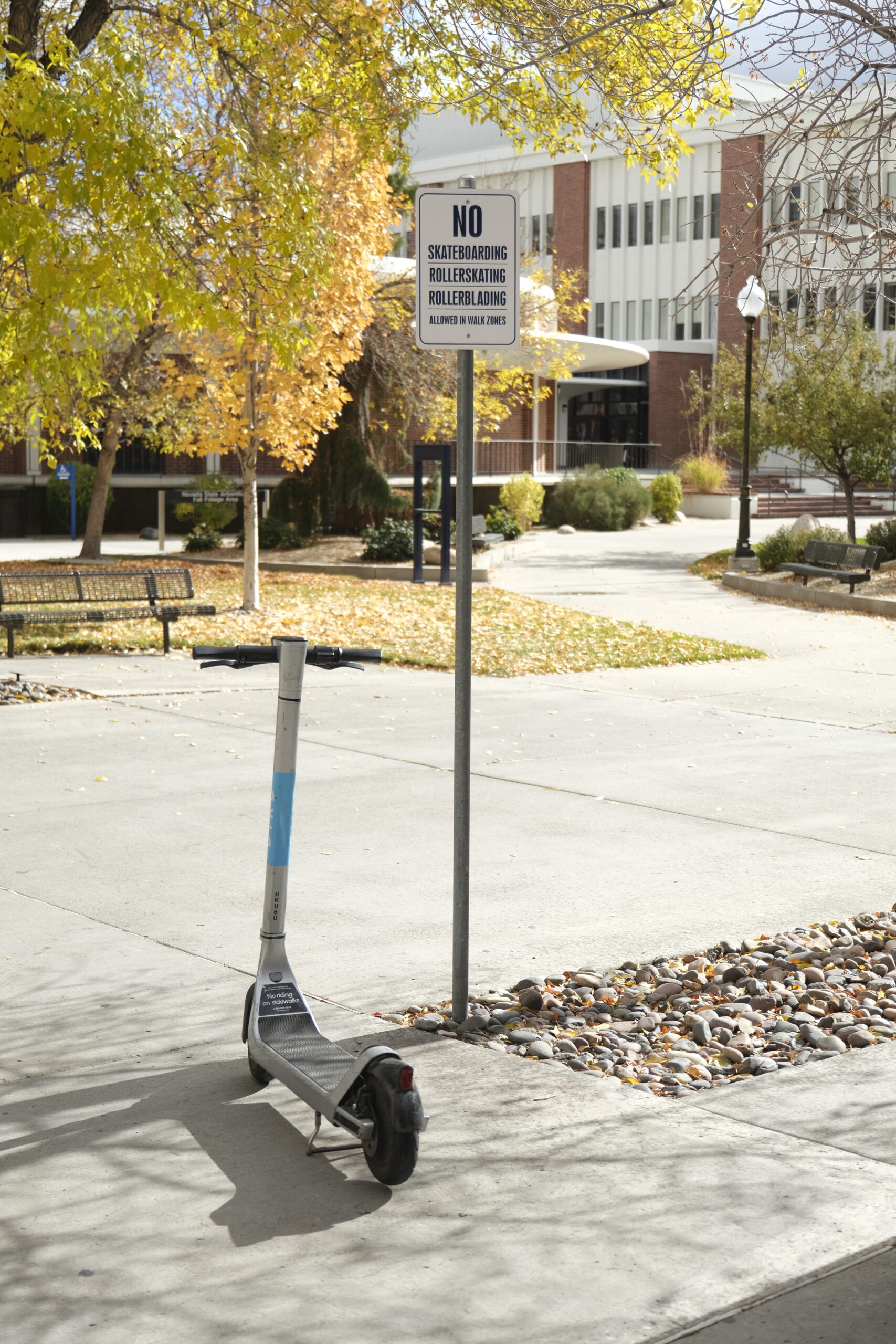It shouldn’t come as a giant surprise that the hyped up and anticipated electric scooter and bike generation has finally arrived. With an increase in energy-based transportation products in stores and online retailers, these newer electric scooters and bikes are available to use and access on streets within a moments reach.
Driving around town, it typically doesn’t take more than ten minutes to spot multiple electric scooters made by the company Bird Global Inc. The gray scooters with a blue logo sticker attached can be seen standing in place on sidewalks or even better – lying flat on the cold, hard ground.
Using the scooters isn’t technically a difficult issue. When intrigued, all the user has to do is install the accompanying Bird app, sign up and add a payment method. Once in, you are shown a map of all the Bird scooters locations that are not currently in use. Of course, if you are in the presence of one at that moment, you can simply just scan the QR code on the scooter’s handle.
After agreeing to certain terms and conditions and going through a short tutorial, you can easily kick the standing mount that’s on the bottom of the scooter up and go on your way by kicking off and pulling down the acceleration lever.
Each minute of riding a Bird scooter is 15 cents, an affordable amount of money considering the amount of reach you can achieve on this transportation method.
Bird scooters became one of Reno’s most popular transportation methods. I have seen dozens upon dozens using the Bird scooters as a fast and cheap method to go from student apartments to their classes on campus. This is a wonderful integration and usage of the scooters considering some walkways and paths could be dangerous to tackle for minorities by foot and to make things better, Bird claims that community members such as students, veterans, teachers, low-income households, nonprofits and hilariously: senior citizens—can get their scooter prices lowered with a 50 percent discount.
The scooters can go 15 miles per hour on a street road and are restricted in pedestrian walkways. The technology involved is very specific and focuses more on ensuring you’re not in pedestrian walkways. This preference could cause misreadings and think you are in an unsafe area for speed even when you may just be in the middle of the road like the app told you to. While this flaw is annoying, it’s more beneficial for it to exist and be wrong. It prevents scooters from accidentally bypassing the limits and putting other walking pedestrians in danger.
Community pricing is actually an amazing step forward for public transportation considering the amount of recent backlash and union controversies other transportation formats are currently suffering from. However, Bird scooters offer their biggest con and issue: not everybody can ride a scooter.
Even though riding a scooter is based on personal skill, Bird scooters are definitely not the safest form of transportation. Though many may have tried and overcome the learning curve of riding a scooter, Bird scooters also act differently than your typical scooter. The scooters do not rely on manually pushing forward and do not have emergency brakes; it can even take an adjusted scooter rider a few minutes to get adjusted to the technology.
The scooter relies on technology to a dangerous extent. For instance, it could be dangerous to slow down the riding when it detects a potential pedestrian walkway while not restricting a scooter that could be next to you, which could potentially cause a crash. It is also worth noting that you have to place both feet back on the scooter before pulling down the acceleration when you kick off the scooter, or else your body weight versus the acceleration speed could sweep the scooter from underneath you. This can be very painful and the fall can leave you with some marks (based on personal experience).
The worst and most dangerous side of this scooter is downhill. When doing downhill, the scooters successfully go beyond the speed limit the acceleration lever can go, resulting in you going upward to 25 miles per hour. In my case: going 25 miles per hour downhill, seeing a hole in the road and attempting to slow the scooter down with their electric break may result with you face planting into the road, getting second-degree burns, a nice little visit from the ambulance and scars on your arms that will last years.
This unfortunately isn’t a rare case either. Some students have ended up at the Student Health Center due to a collision, some minor and others temporarily disabling.
Besides the injuries, another one of the Bird scooters unfortunate restrictions is distance. Most of the scooters are restricted by the map and all riders will have to stay within a certain range or area of the map. In our case: downtown Reno for the most part is the only area of town people can ride scooters in. You cannot ride the Bird scooter inside the university, but you can ride them on the outskirts.
With the rise of the scooters, you also begin to question college students using it as a form of travel when intoxicated. This simply just risks the lives of the rider or any other people sharing a road, sidewalk or bike lane. It’s a topic to consider and an issue to address, though from the outside it is easily overlooked.
Besides the Bird Scooters, the university started experiencing issues of scooter, skateboard and bike riders risking the lives and safety of our students walking between classes or on campus. These fast riders zip through crowds. All it would take is one student with headphones on to take a wrong step, not knowing what is behind them and then being run over, causing an accident. We need to remember to not speed through zones where crowds of students may be walking or socializing due to their safety, but the riders egos and inconsiderate notions result in different expectations.
After finishing a ride, Bird scooters can be left anywhere. I’ve seen Bird scooters inside my apartment complex behind locked doors, on the side of roads or on the sidewalk. Since the Bird scooters are electric, they do need to be charged.
In a program with Bird, people can be paid for picking up the scooters from locations, taking them home and charging them. According to Inc., “Birds must be collected and recharged every night. Bird pays from $5 to $20 per scooter per charge depending on how difficult it is to locate it and how much juice it needs.” I have seen a lot of trucks picking up Bird scooters near my apartment complex or around town and hauling groups of 30+ scooters home to charge. With the payment that much for an easy task: I cannot blame them! Easy cash! Though I do wonder how they access scooters locked behind or within an apartment complex.
The other issue with Bird scooters is cleanliness. When I fell off my scooter, I was bleeding everywhere and the scooter never got cleaned until it was collected for charging, according to Bird. This is simply why I am honestly disgusted to use the scooter anymore considering how many injuries, accidents or other forms of unhealthy interactions the scooters may come across in a day and a rider wouldn’t know about. The idea that my Bird scooter was still around town that day stained with my blood while another rider uses it is quite frightening.
Bird has become one of the most fascinating and integrated community level electric transportation services of all the new retailers. If you do not want to share your scooter, on Bird’s official shop you can buy a personal scooter for $599, assuming they restock them! You can also from the allotment of electric scooters available across multiple companies and brands from an online retailer or local shop.
Though I may have scars that will last me for many years, the Bird scooters truly are an exciting and fun way to travel. They offer affordable use to those in the community who are suffering from a lack of transportation methods and provide it in a fun and engaging way. Overall, the scooters have improved the lives, but also harmed the healthy skin, of many as well.
Opinions expressed in The Nevada Sagebrush are solely those of the author and do not necessarily express the views of The Sagebrush or its staff. Gabriel Kanae is a student at the University of Nevada studying journalism. They can be reached at edrewes@sagebrush.unr.edu and on Twitter @NevadaSagebrush.









